US, Japan Korea Defy New China Air Defense Zone, Biden To Rebuke Beijing; PRC Move Drives Korea, Japan Together
Posted on
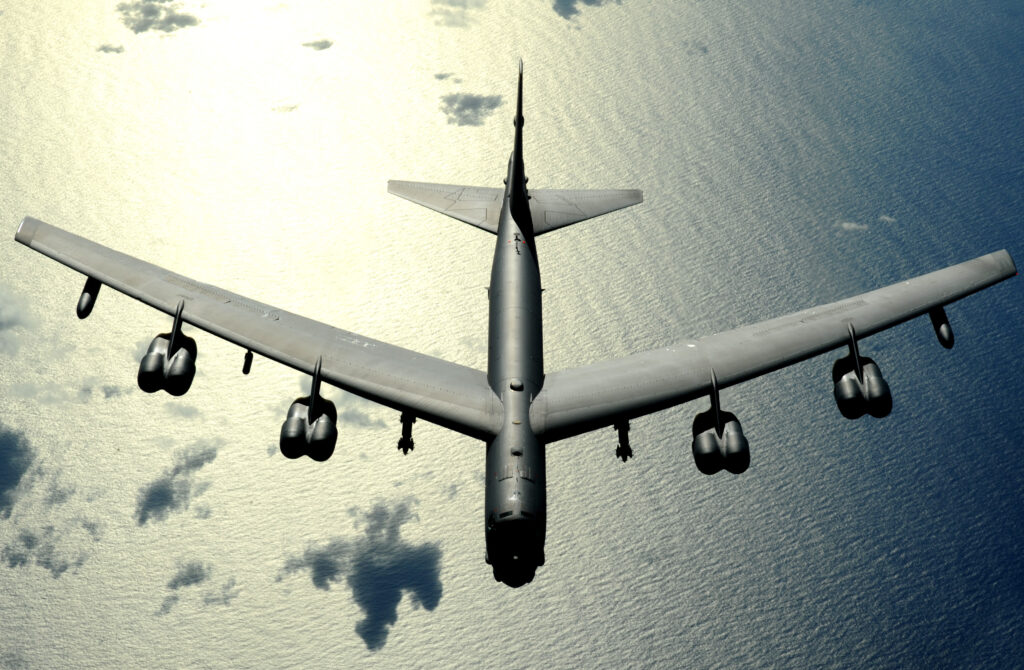
A US Air Force B-52 flies from Guam out over the Pacific. Bombers like this one breached China’s air defense zone Tuesday.
UPDATED: US Flies B-52 Bombers Through Chinese Zone; Japanese & South Koreans Follow; VP Biden To Ask Beijing For “Clarity” On Their Intentions
China escalated tensions with Japan literally sky-high last weekend. After years of shadowboxing at sea around the Senkaku Islands, China’s Ministry of Defense announced a new “Air Defense Identification Zone” with authority to oversee and, implicitly, even intercept aircraft flying over the disputed waters, includes Japanese and American military planes. That raises the ugly prospect of repeating the 2001 collision off Hainan that killed a Chinese fighter pilot, downed a US Navy spyplane, and left 24 Americans in Chinese captivity for 11 days.
[UPDATED 12:45 pm Tuesday: Reuters just reported America’s first challenge to China in this crisis, a flight through the newly declared air defense zone by two US military aircraft that elicited no Chinese response. The Wall Street Journal‘s Julian Barnes identified them as Air Force B-52 bombers flying out of Guam. That means the US sent two of America’s oldest, biggest, least stealthy, and least agile aircraft from a long way away. They should have been easy for Chinese radar to spot and for Chinese fighters to intercept — but whether the Chinese saw them coming or not, Beijing did nothing.
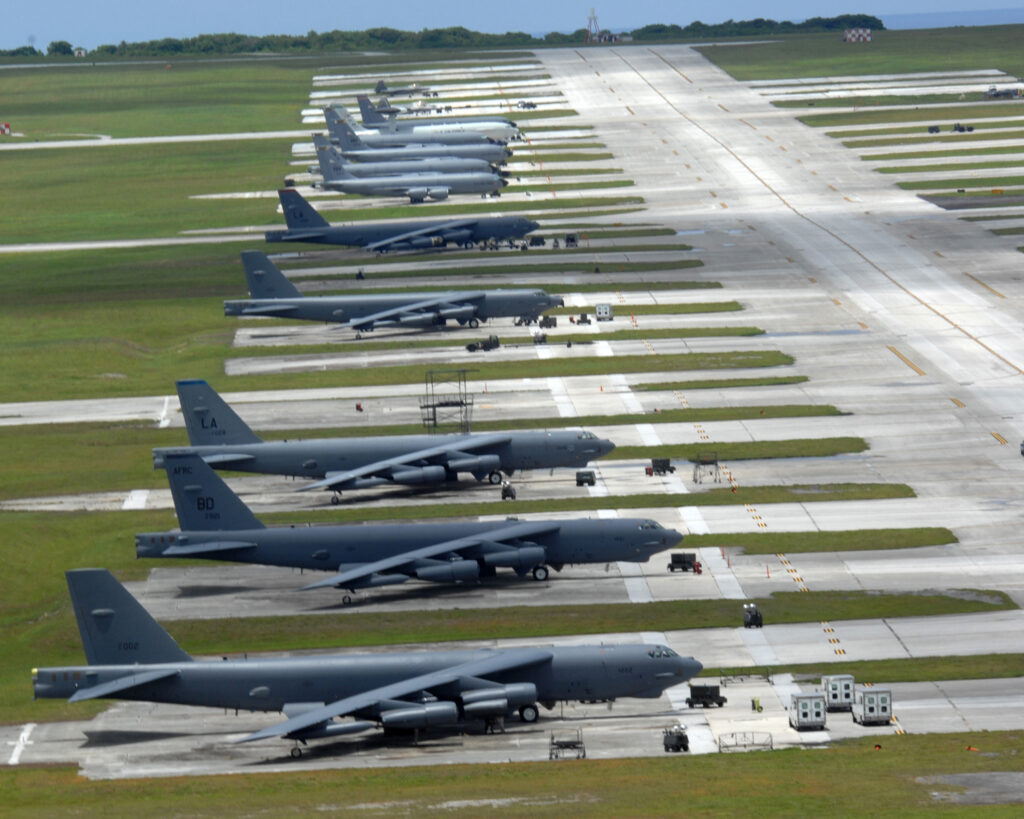
B-52s lined up at Andersen Air Force Base on Guam, where the bombers that challenged China’s air defense zone came from.
“We have conducted operations in the area of the Senkakus,” Defense Department spokesman Col. Steve Warren told Reuters. “We have continued to follow our normal procedures, which include not filing flight plans, not radioing ahead and not registering our frequencies.” Those are all things that China’s unilaterally proclaimed flight rules forbid.
Meanwhile, Japan’s government has successfully pressured its two largest commercial airlines not to file flight plans with the Chinese. Taiwan and South Korea, by contrast, have made such filings a requirement. China has promised not to interfere with commercial flights.]
[UPDATED 9:50 am Thursday: This morning, both Japan and South Korea flew their own military aircraft through the zone without informing Beijing beforehand. The Chinese response? Again, nothing].
So China has yet to do anything to exercise its new claim over the islands, which are controlled by Japan but also claimed by China. Instead of bolstering China’s position, just making the claim seems just to have stiffened anti-Chinese sentiment in Japan, the US, and — most counterproductive of all from Beijing’s perspective — South Korea.
This is just the latest instance where China’s aggressive policy in the West Pacific has helped the United States’ position in the region instead of weakening it, inspired resistance instead of concessions, and undermined Chinese “soft power” diplomacy instead of reinforcing it. “They’d been so effectively bad-mouthing the Japanese and winning support from the Koreans,” said Phillip Saunders, director of the Center for the Study of Chinese Military Affairs at the National Defense University. “But it [the air defense zone] unnecessarily antagonizes people other than Japan.”
[UPDATED 10:00 am Wednesday: Beijing even managed to pick almost the worst possible timing: Vice-President Joe Biden is departing DC the Monday after Thanksgiving to visit China, Japan, and South Korea, giving the US a high-profile opportunity to rebuke Beijing and encourage its allies.
“The Vice-President is not going to Beijing to deliver a démarche,” a senior administration official told reporters Wednesday morning, nor will he be “mediating” the disputes between Korea’s Park and Tokyo’s Abe. But Biden will encourage dialogue among all three countries to reduce tensions — and he will press China “to clarify its intentions.” (Given the complex closed-door horsetrading that produces Chinese policy, however, it’s not certain the Chinese policymakers themselves have much clarity on what their strategic logic is here, if they even have one).
The official declined to say specifically whether Biden would ask the Chinese to undo the zone instead of just explaining it, but he made clear the vice-president is going to convey American displeasure. “We have real concerns with this move by the Chinese because it raises serious questions about their intentions, it causes friction and uncertainty, it causes a unilateral change to the status quo in a region [which] is already fraught,” he said. “It also allows the vice-president to make the broader point that there is an emerging pattern of behavior” — not just one incident — “that is unsettling to China’s own neighbors.”]
“This ancient civilization, which has thousands of years of diplomatic experience and gave us Sun Tzu and all his subtlety, has given us some ham-handed diplomacy for the last few years,” one geostrategist told me. “It’s not just the air defense zone, which is needlessly provocative in itself”: It’s a host of greater and lesser provocations, from bumbling its response to the Typhoon Haiyan disaster in the Philippines to building outposts on disputed islets. In this case, Beijing drew the air defense zone so broadly that it infringes not only on Japanese territorial claims but on South Korean ones as well.
“It basically throws cold water on the South Korea government in its efforts to engage with China,” said Ellen Kim, assistant director of the Korea program at the Center for Strategic and International Studies. Korean President Park Geun-hye made sure to meet with China’s new leader, Xi Jinping, while pointedly stiff-arming Japan’s Prime Minister Shinzo Abe. That stance played well with the many South Koreans who resent Abe’s refusal to acknowledge the true brutality of three decades of Japanese occupation. But the Saturday declaration came as a “shock,” Kim told me, “and this certainly affects public opinion about China.”
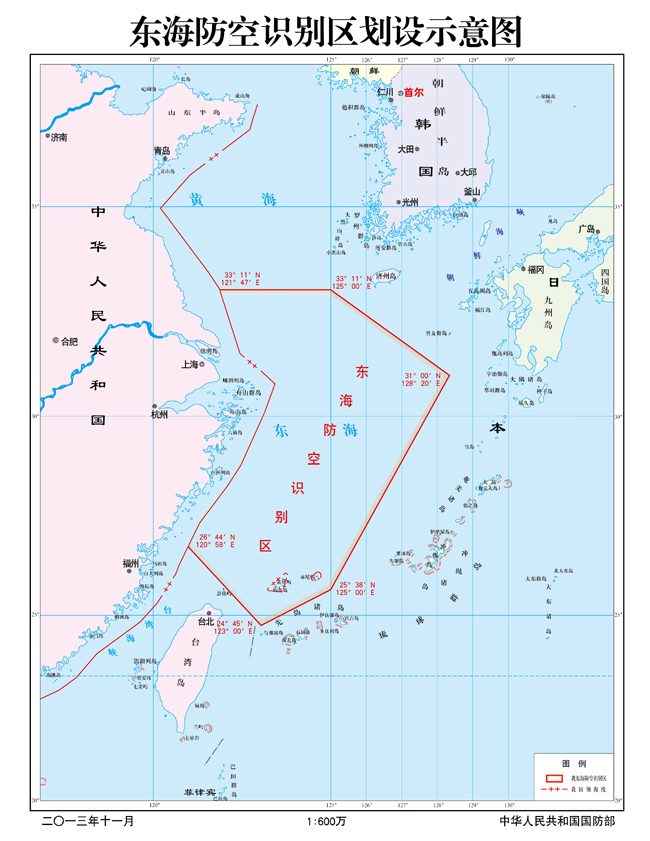
China’s official map of its new Air Defense Identification Zone, which overlaps both Japanese and South Korean claims.
Specifically, the new air defense zone covers Ieodo Island, an uninhabitable reef, where Beijing and Seoul have disputed ownership for years, and it overlaps South Korea’s preexisting air defense zone by a strip more than 70 miles long and 12 miles wide. So after years of cultivating Seoul and exploiting 137 years of enmity between South Korea and Japan, the Chinese have managed to give the two mutually distrustful democracies something to agree on.
Two years ago, Seoul shut down remarkable talks with Tokyo that would have resulted in sharing highly classified intelligence. The relationship, at best, is one of fits and starts. This year, the two nations’ navies participated in a well-publicized joint exercise, though they still needed the US as chaperone, and their pilots trained together in the US Air Force’s Red Flag wargames. This Saturday, China did more to advance the cause of Japanese-Korean cooperation than have years of American nudging.
Not everyone I talked to was optimistic. “Are we actually going to see Japanese and South Korean cooperation grow out of this?” asked Heritage Foundation expert Dean Cheng. “If we do, I’ll be the first to agree I was wrong and the Chinese have shot themselves in the foot.” So far, though, he argued, Chinese provocations have provoked stern rhetoric and a much-hyped but underfunded US “Pacific pivot,” but no really effective strategic response. “Yeah, they’re not going to win homecoming queen,” Cheng told me. “How much does that bother them?”
Every other expert I talked to, however, agreed that the Chinese strategy is self-defeating. “In provoking everyone, they are once again overshooting,” said Patrick Cronin, head of the Asia-Pacific Security Program at the Center for a New American Security.
“It is a deliberate policy approved at the highest levels,” Cronin told me, but that doesn’t make it a good one. Nor does it mean that the top leaders can fully control what they unleash. “Policy machinery is cumbersome and bureaucratic, [and] many military and civilian law-enforcement agency activities are delegated and locally driven, rather than some clever, thought-through, top-down decision made in Beijing,” he said. The People’s Liberation Army in particular “is an increasingly independent actor.”
That doesn’t mean the PLA is out of control, let alone defying its civilian masters in some kind of Strangelovian rush to war. The problem is that the Chinese military speaks with a louder voice than any civilian agency when it comes to the Western Pacific.
The recently concluded Third Party Plenum did pledge to create a civilian-led “National Security Council” or “State Security Council” (either translation is apparently correct). So far, though, all public signs are that the council will focus on internal security against “terrorists, extremists, and separatists” rather than on external affairs, although Cronin’s Chinese sources tell him it will play a major role in both. Whatever happens with the Chinese sort-of-NSC, however, for now the military has clearly taken the lead.
To start with, it was China’s Ministry of Defense that announced the Air Defense Identification Zone on Saturday (at 10 am Beijing time, 11 pm Friday here). Since then, the civilian Foreign Ministry has played a relatively quiet and supporting role, making just two official comments on the subject, while the Defense Ministry has noisily played the lead. Just compare the Foreign Ministry homepage — the lead item is about the British Prime Minister’s forthcoming visit — to the Defense Ministry’s blaring red website.
It’s worth noting that the Foreign Minister does not sit on the Chinese Politburo. It’s also worth noting that China’s Defense Minister is always a serving military officer, not a civilian political appointee like the US Defense Secretary. In fact, the only civilian on the Central Military Commission that sets defense policy is President Xi Jinping himself.
“He’s capable of making his own judgments,” said NDU’s Saunders, “[but] military influence is a concern: how the issue is framed, what the response is that’s proposed, and the extent to which the pros and cons are fully vetted” — for example, potential blowback from Korea.
When you’re surrounded by people with hammers, you might just succumb to the groupthink that every problem is a nail. Chinese decision-making is notoriously opaque, but Saunders’ working hypothesis is that Beijing declared the air defense zone out of frustration over the Senkakus.
“They clearly chose to make a big issue of it after the Japanese government purchased the islands [from a private owner in 2012], and having done that they haven’t got much satisfaction,” Saunders told me. “China being stuck, [this was] probably a military proposal: ‘Here’s something we can do, Japan already did it, so it’s a reasonable response.'”
Of course, the Japanese had their air defense identification zone over the Senkakus long before Saturday: In fact it was set up by the US occupying forces after World War II. To a Chinese nationalist, though, that simply means the Chinese zone is long overdue, a redress of historical wrongs made possible by his country’s growing strength.
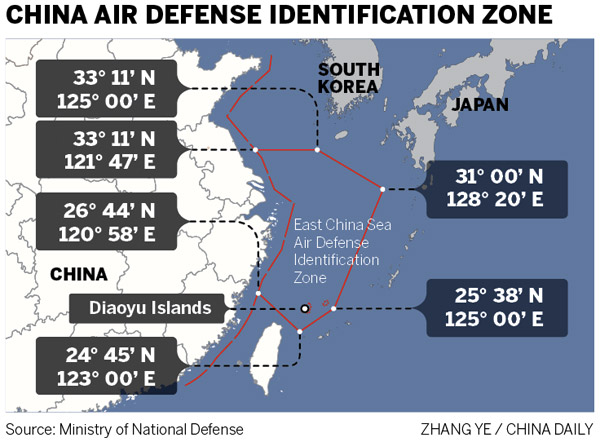
The new “Air Defense Identification Zone” covers the Japanese-controlled Senkaku Islands, which China calls the Diaoyus.
“The Chinese have hit a certain level of technological capability,” Cheng told me: sophisticated Sukhoi fighter-bombers with the range to patrol the zone, sensors and satellites to pick up intrusions, command and control facilities both ashore in and AWACS-style flying command posts to coordinate it all. “The Chinese are benefiting from over a decade of steady investment,” he said, in what the US calls “anti-access/area denial” and what the Chinese call “counter-intervention.”
But how will China use these new capabilities? “We don’t know how they’re going to enforce this ADIZ,” Cheng said. “Eventually they’re going to have to issue ROEs [rules of engagement] and all that kind of stuff, and that’s when things get really scary.” When a US or Japanese military aircraft trespasses on the air defense zone, will the Chinese content themselves with irate radio messages, send up their own fighters to shadow the foreign planes from a safe distance, or actively try to drive the intruders off? It’s that last scenario that raises the specter of the Hainan Island crisis 13 years ago.
At sea, the People’s Liberation Army Navy has largely stayed in a supporting role while Chinese coast guard vessels pushed ahead into disputed waters. That’s not an option in the air. The Chinese do have some civilian maritime patrol planes, but the vast majority of their airpower is in PLA Navy aviation and the People’s Liberation Army Air Force. Japan, for its part, has scrambled Air Defense Force jets in response to past Chinese fly-bys and has threatened to shoot down Chinese drones.
In the US, Defense Secretary Chuck Hagel has pledged to continue its normal military operations in the zone. [UPDATED: Hagel spoke to Japan’s Defense Minister Wednesday morning about this “potentially destabilizing unilateral action” and emphasized once again that America’s defense treaty with Japan does cover the Senkakus, although he also did “commend” Japan for “for exercising appropriate restraint” so far.] The influential Republican Rep. Randy Forbes, head of the House Armed Services subcommittee on seapower, [UPDATED: spoke with the Japanese ambassador on Wednesday and] has called for additional military “presence and exercises…in and around these disputed areas.” So any aerial confrontation would probably have warplanes on both sides.
The world already got a taste of how dangerous the Senkaku standoff can get in February, when a Chinese warship “painted” a Japanese vessel with its targeting laser. Neither side went further — but there’s much less time to think when the opponents are streaking across the sky at a few hundred miles an hour instead of cruising on the sea. “If you do that in the air, you could have some really nasty effects,” Cheng said.
I don’t think any significant faction in China’s leadership, civilian or military, actually wants a war with Japan, let alone with the United States. But the more provocatively China behaves, and the more the military takes the lead in those provocations, the more the chance that some junior officer will do something lethally stupid.
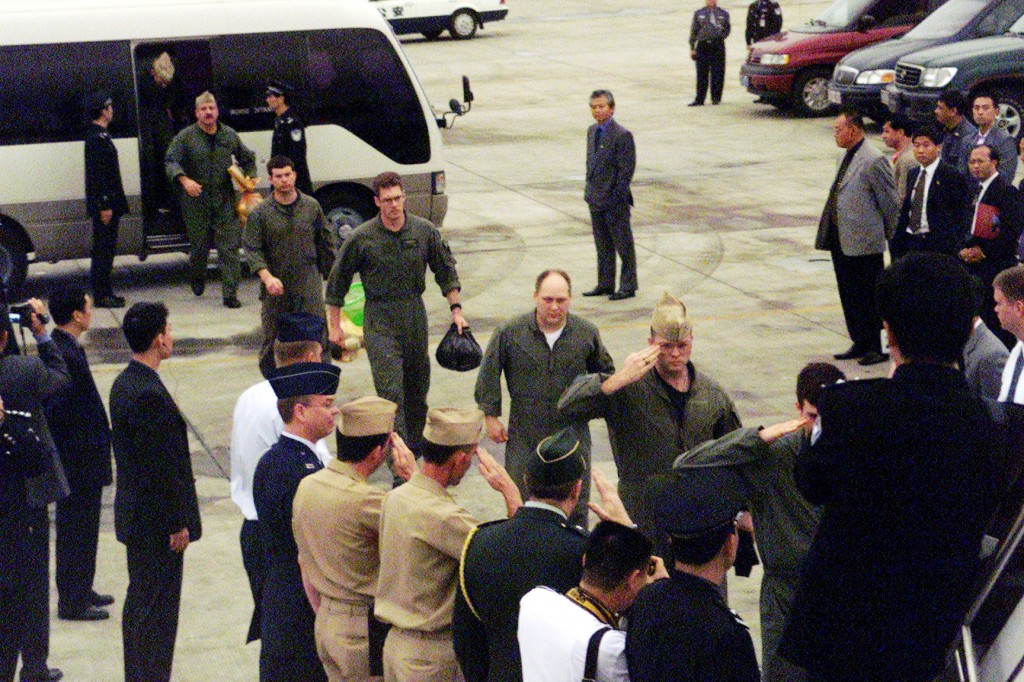
After 11 days in Chinese hands, the crew of a downed US Navy EP-3 spyplane leave Hainan Island in 2001.
Subscribe to our newsletter
Promotions, new products and sales. Directly to your inbox.
